Comment—End of an era
I FIRST met the then new Chief Executive Officer of British Waterways, Robin Evans, when he was opening the restored section of the Chesterfield Canal up to Norwood Tunnel, ten years ago, writes Tom Crossley.
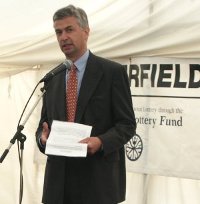 He came at the age of the renewal of the disused canals, with the Chesterfield the latest after the massive complete restorations of the Kennet & Avon, Huddersfield Narrow, Rochdale and of course the Anderton Lift.
He came at the age of the renewal of the disused canals, with the Chesterfield the latest after the massive complete restorations of the Kennet & Avon, Huddersfield Narrow, Rochdale and of course the Anderton Lift.
Money lost
His entry witnessed the end of all that, with excessive amounts of money being lost on scheme after scheme, compounded by the loss of some very good staff by the insistence on changing the area boundaries and offices—not once but twice. Then there was the change of headquarters, again not once, but twice. What havoc all this caused to both morale and staff we were not privileged to know, as neither do we know of the actual cost.
 Then came the decision to install bollards at narrow locks, causing not only boats being hung up, but coupled with the lack of the famous Veg Pledge—yet another good idea than went by the board—causing them to become hazards. So out they came, but not to be thwarted, in went wooden square one—that have proved equally useless.
Then came the decision to install bollards at narrow locks, causing not only boats being hung up, but coupled with the lack of the famous Veg Pledge—yet another good idea than went by the board—causing them to become hazards. So out they came, but not to be thwarted, in went wooden square one—that have proved equally useless.
Maintenance started to suffer
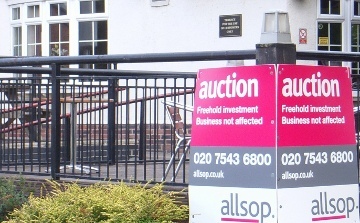 Again at what cost we can only guess, but such waste of course was having its repercussions—maintenance started to suffer.
Again at what cost we can only guess, but such waste of course was having its repercussions—maintenance started to suffer.
Then it was the turn of the big spenders and 'investment' time. Just as the pub industry was feeling the pinch and cutting back, one brewery found a sucker indeed in the form of British Waterways who took over—was it 100?—of its pubs. We all know what happened to them.
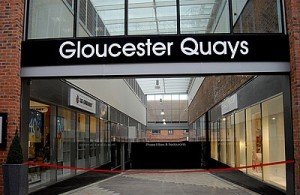 Then it was into shopping precincts—£33 millions down the drain this time as British Waterways wrote off its 'investment' at Gloucester Quays. So now maintenance of the waterways was really suffering.
Then it was into shopping precincts—£33 millions down the drain this time as British Waterways wrote off its 'investment' at Gloucester Quays. So now maintenance of the waterways was really suffering.
Though British Waterways had started its own campaign to encourage marina building, in 2004 it also started buying them up, once again as an 'investment' to 'provide money for the upkeep of the waterways'. Though untold millions of pounds have been involved in the purchase of 20 marinas, only a token amount has found its way to the 'upkeep of the waterways', any profit going to its own marina aggrandisement.
So more money lost to the waterways—real money.
Sold at a fraction of value
At least the past had seen some good investment in property in London, but for some obscure reason it was decided to sell it off, at a fraction of its real cost, with some very delighted new owners. Some thought it most suspect.
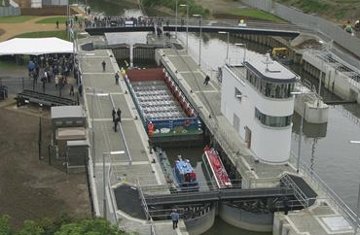 Most of you will know of the Three Mills Lock fiasco, where over £20 millions were spent on building a lock to carry the building materials to construct the Olympic stadium, with a member of parliament having to admit that the equivalent of only one and a half barges full had passed through.
Most of you will know of the Three Mills Lock fiasco, where over £20 millions were spent on building a lock to carry the building materials to construct the Olympic stadium, with a member of parliament having to admit that the equivalent of only one and a half barges full had passed through.
But to add to the fiasco, later £435,000 was spent on 'sprucing-up' Blue Bridge on the same waterway in readiness for the huge increase in boat traffic—that of course never materialised.
Just think what maintenance that lot would have completed.
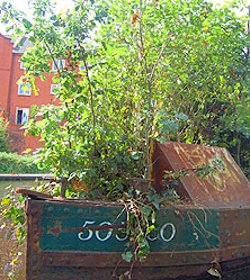 Silly season
Silly season
Then came the silly season, with money thrown at the most outlandish of schemes—remember the £50,000 spent on a 'forest in a narrowboat' that after just a few months the boat could not move as the trees had grown too tall to go under the Midlands bridges and of course could not be cut. Many boaters wondered about that extraordinary cost, a few trees in a disused workboat—£100 at the outside. Surely something very wrong.
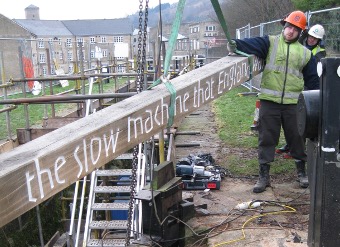 Poetry on lock gates was another one. Whilst many gates were crumbling, those that were being repaired had money wasted on them inscribing was has come to be known as 'potty poetry'.
Poetry on lock gates was another one. Whilst many gates were crumbling, those that were being repaired had money wasted on them inscribing was has come to be known as 'potty poetry'.
At the moment more is being wasted on another near-sighted scheme—planting fruit trees by the towpaths. Little realising that in a few years their ever extending roots will be damaging the canal banks.
By now, the result of such a waste of money had resulted in a huge maintenance backlog
Little to celebrate
Let us not forget that triumphant metamorphosis into Canal & River Trust, with £23,720 spent on flags and bunting to celebrate. But with little to celebrate they were not used, and no one seems to know what became of them.
By now maintenance was at an all time low, and from the many successful waterway restorations of before, there now was not even the money to continue the involvement in the Cotswold Canals restoration.
The formation of CaRT brought its many hangers-on, each with their own pet schemes, so water voles, bats and insects of all description now have money thrown at them, notwithstanding all these already have their own well established organisations looking after their welfare.
Silence
When any head of any large organisation leaves after ten years of service, he or she goes with a fanfare of the achievements during that period. Yet Robin, no longer in control, has slipped away—the silence is deafening.
Perhaps all those directors that too were responsible for so many of these decision should quickly follow suit.
But welcome Richard Parry. We can but hope.
